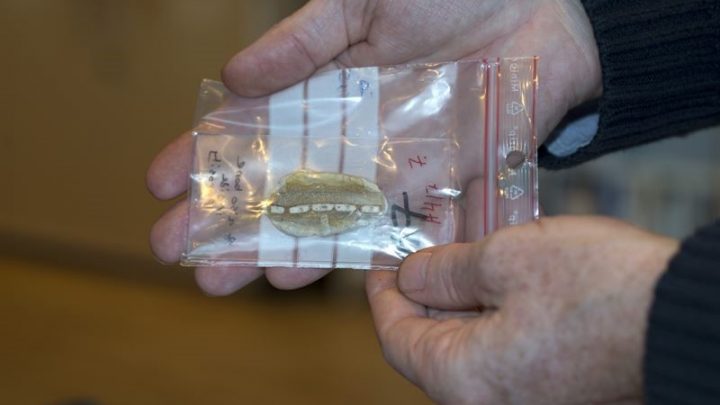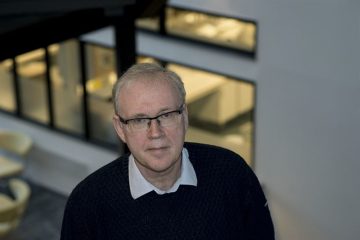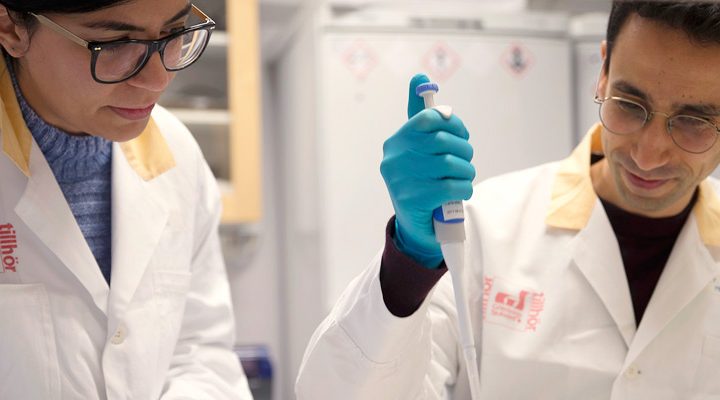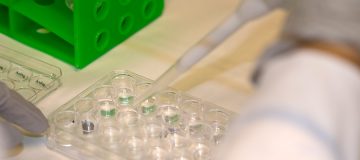
RESEARCH. Sometimes a traditional prosthesis is not enough when large amounts of bone need replacing. This includes injuries where a large piece of bone has been broken off or if a piece of the skullcap has been removed as part of a brain tumor operation. Peter Thomsen, professor at the Department of Biomaterials, is working with materials researchers to study ceramic materials that can be used to repair these types of major bone defects. While the material gradually breaks down and disappears, it stimulates new growth of the patient’s own bone.
A ceramic is an inorganic, non-metal material that is often a composite. The ceramics that Peter Thomsen studies consist of calcium phosphate and stimulate the patient’s own cells to begin forming bone. One of the ceramics, developed by Professor Håkan Engqvist at Uppsala University, has been produced for a few years for clinical use by a medical device company in Uppsala. Peter Thomsen’s interest is in trying to understand how ceramics stimulate bone to regenerate.
“We see very complex signal paths between different cells when new bone forms. It is in the micro environment by the ceramic that bone growth occurs. We believe proteins, disintegrating ceramics and other factors play a role for synthesis of apatite, which is what bone is a major component of bone material, but we also have reason to believe that signals between different cells are involved. For example, extracellular vesicles, a type of blister, are transported between stim cells and inflammatory cells. When these vesicles bind to material surfaces, this increases the ability of stim cells to bond and divide.”
A hit to the head offered an invaluable opportunity
One of the first patients to have the ceramic material implanted was unlucky enough to receive a hit to the head a few years later, which caused the ceramic to bend and required replacement. But there was a silver lining to the story. This gave the researchers an invaluable opportunity to study what had happened with bone regeneration in the replaced ceramic.

“Just as we had seen in experiments on sheep, the ceramic was being replaced by new bone. It consisted of both bone regenerating and bone decomposing cells and blood vessels. The chemical composition was also identical to that of the patient’s existing bone.”
Peter Thomsen says that there has never been a more exciting time to be involved in research. He is surrounded by such nice, inquisitive young people and feels that the research is more invigorating than ever.
“It is extra fun to work ‘beyond titanium’. Most work with material development for implants and prosthesis, particularly in Gothenburg, has traditionally related to titanium. Many of us feel that titanium is good since it integrates with the bone, but it does not lead to new formation of bone like the new ceramic materials do.”
The material sends signals to the tissue
The researchers have understood that some type of signals from the ceramic material attract cells that form new blood vessels and bone. When the ceramic is implanted in soft tissue in sheep, new bone forms at the spot, even though normally there would be nothing there related to bone.

“If we instead implant titanium in soft tissue, absolutely nothing happens that leads to new bone. The ceramic may be sending out signals that attract cells that can form both different types of bone cells and blood vessels.”
To develop the right ceramic, the research team has looked for a material that is tissue-friendly, is reabsorbed and disappears from the body, and stimulates new bone growth.
“We have tested many different materials and have had some luck as well. Well, maybe it wasn’t luck. There is a large degree of material chemical expertise behind this.”

Unusual sequences are made visible in drops
Peter Thomsen believes that the ceramics attract circulating stim cells, but this is only an hypothesis so far and is not yet proven. To find out which cells are involved in the new formation of bone, how the signaling occurs and what genes these signals regulate requires sensitive methods since the number of cells is so small. One method that can do this is called digital PCR. The grant from the Lundberg Foundation will be used to purchase equipment for this. Normally researchers search for specific DNA and RNA sequences in an entire sample. Digital PCR, however, involves dividing samples into extremely small drops with only one or two DNA or RNA strands in each drop. When looking for the specific sequence in each drop, it is easier to find sequences with few examples in the drop. If the entire sample was analyzed all at once, you risk missing what you are looking for since they are easily obscured by all the other more common sequences.
Thomsen is very thankful for the grants from the Lundberg Foundation that he has received of the last two decades.
“Without them, we would never have been able to raise our research to the level it is at today. The Foundation is unique in that it provides grants for equipment in the range between small devices and really large and expensive equipment. Otherwise, it is nearly impossible to get grants for this type of equipment.”
TEXT AND PHOTO: ANNIKA SÖDERPALM / THE LUNDBERG FOUNDATION










